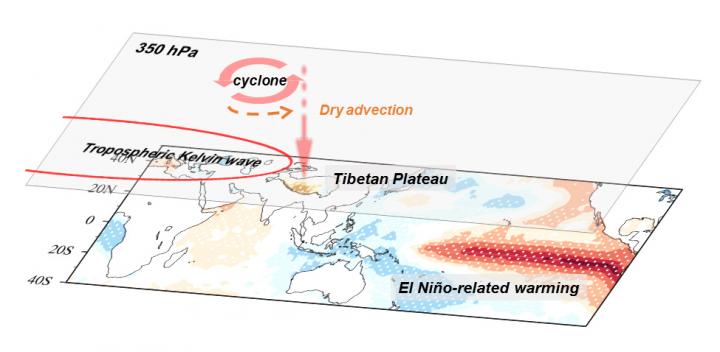
Credit: Shuai Hu
El Nino-Southern Oscillation (ENSO) is a recurring climate phenomenon involving changes in the temperature of waters in the central and eastern tropical Pacific Ocean. It is one of the most important climate perturbations on Earth because it can change the global atmospheric circulation, which in turn, influences temperature and precipitation across the globe. Scientists have found ENSO has an impact on hydroclimate over the Tibetan Plateau but how it works, or its physical mechanism, remains unclear.
In a recently published research article in Journal of Climate, Shuai Hu, Tianjun Zhou and Bo Wu from the Institute of Atmospheric Physics, Chinese Academy of Sciences, explored the dynamical processes that cause the year-to-year variation of summer rainfall over the Tibetan Plateau during the developing ENSO events.
They found that the summer rainfall over the southwestern Tibetan Plateau is more sensitive to the ENSO forcing. During a developing El Nino event occurred on the tropical eastern Pacific, the southwestern Tibetan Plateau located at the Inner Eurasia usually suffer a serious drought, despite a vast distance between the two regions (about 18000 km).
According to data from different sources and the process-based analysis, the authors revealed that the anomalous advection of climatological moist enthalpy (mainly dry advection) by anomalous zonal wind induced by ENSO is responsible for the anomalous descending motions, and the suppressed rainfall over the southwestern Tibetan Plateau. In this process, the suppressed Indian summer monsoon precipitation and the tropical tropospheric Kelvin wave play a key role of intermediate bridge.
“I hope our study may help improve the prediction of rainfall changes on the Tibetan Plateau, and understand the complicated ENSO-related air-sea interaction responsible for the hydroclimate of the Tibetan Plateau.” said HU.
###
Media Contact
Ms. Zheng Lin
[email protected]
Original Source
http://english.
Related Journal Article
http://dx.




